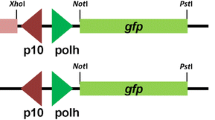Abstract
A system is described for the rapid generation of Bombyx mori nucleopolyhedrovirus (BmNPV)-based expression vectors. A series of novel BmNPV genomes, that include a mini-F replicon and therefore can be maintained in Escherichia coli, have been generated. These genomes lack a portion of the essential ORF1629 gene and cannot replicate independently in insect cells. However, they can be used as parental genomes for the generation of expression vectors by cotransfection with a transfer plasmid that includes an intact ORF1629. Only recombinant viruses that have acquired the ORF1629 gene from the transfer vector, and have therefore also acquired the foreign gene of interest, can replicate after cotransfection. Parental genomes with and without a polyhedrin gene are described, enabling the generation of occlusion-positive and occlusion-negative recombinant viruses. Occlusion-positive expression vectors enable the oral infection of B. mori larvae and can therefore be used for the mass production of a foreign protein in infected insects.
Similar content being viewed by others
References
Choi JY, Lee HK, Hong HK, Je YH, Park JH, Song JY, An SH, Kang SK (2000) High-level expression of canine parvovirus VP2 using Bombyx mori nucleopolyhedrovirus vector. Arch. Virol. 145: 171–177.
Hong HK, Woo SD, Choi JY, Lee HK, Kim MH, Je YH, Kang SK (2000) Characterization of four isolates of Bombyx mori nucleopolyhedrovirus. Arch. Virol. 145: 2351–2361.
Jarvis DL (1997) Baculovirus expression vectors. In: Miller LK, ed. The Baculoviruses. New York: Plenum Press, pp. 389–431.
Je YH, Chang JH, Choi JY, Roh JY, Jin BR, O'Reilly DR, Kang SK (2001) A defective viral genome maintained in Escherichia coli for the generation of baculovirus expression vectors. Biotechnol. Lett. 23: 575–582.
Kitts PA, Possee RD (1993) A method for producing recombinant baculovirus expression vectors at high frequency. BioTechniques 14: 810–817.
Laemmli UK (1970) Cleavage of structural proteins during the assembly of the head of bacteriophage T4. Nature 227: 680–685.
Lee HK (2000) Construction of a new occluded baculovirus expression vector system. M. Sci. Thesis, Seoul National University.
Luckow VA, Lee SC, Barry GF, Olins PO (1993) Efficient generation of infectious recombinant baculoviruses by site-specific transposon-mediated insertion of foreign genes into a baculovirus genome propagated in Escherichia coli. J. Virol. 67: 4566–4579.
Luque T, O'Reilly DR (1999) Generation of baculovirus expression vectors. Mol. Biotechnol. 13: 153–163.
Maeda S (1989) Expression of foreign genes in insects using baculovirus vectors. Annu. Rev. Entomol. 34: 351–372.
Miller L (1997) The Baculoviruses. Dordrecht, Boston, London: Kluwer Academic Publishers.
O'Reilly DR, Miller LK, Luckow VA (1992) Baculovirus Expression Vectors-A Laboratory Manual. New York: W.H. Freeman and Company.
Possee RD, Sun TP, Howard SC, Ayres MD, Hill-Perkins M, Gearing KL (1991) Nucleotide sequence of the Autographa californica nuclear polyhedrosis 9.4 kbp EcoRI-I and-R (polyhedrin gene) region. Virology 185: 229–241.
Reis U, Blum B, Von Specht BU, Domdey H, Collins J (1992) Antibody production in silkworm cells and silkworm larvae infected with a dual recombinant Bombyx mori nuclear polyhedrosis virus. Bio/Technology 10: 910–912.
Vialard JE, Richardson CD (1993) The 1,629-nucleotide open reading frame located downstream of the Autographa californica nuclear polyhedrosis virus polyhedrin gene encodes a nucleocapsid-associated phosphoprotein. J. Virol. 67: 5859–5866.
Author information
Authors and Affiliations
Rights and permissions
About this article
Cite this article
Je, Y.H., Chang, J.H., Hyang Kim, M. et al. The use of defective Bombyx mori nucleopolyhedrovirus genomes maintained in Escherichia coli for the rapid generation of occlusion-positive and occlusion-negative expression vectors. Biotechnology Letters 23, 1809–1817 (2001). https://doi.org/10.1023/A:1012475004212
Issue Date:
DOI: https://doi.org/10.1023/A:1012475004212




